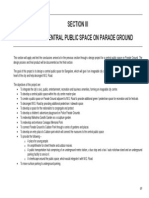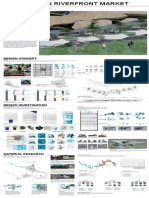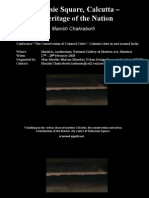Tower Junction Board L
Tower Junction Board L
Uploaded by
camiayoungCopyright:
Available Formats
Tower Junction Board L
Tower Junction Board L
Uploaded by
camiayoungOriginal Description:
Original Title
Copyright
Available Formats
Share this document
Did you find this document useful?
Is this content inappropriate?
Copyright:
Available Formats
Tower Junction Board L
Tower Junction Board L
Uploaded by
camiayoungCopyright:
Available Formats
!
!
!
RAILWAY
LINCOLN ROAD
BIG
BOX
RETAIL
RESIDENTIAL
HAGLEY PARK
EVENTS
RESIDENTIAL
PERCENTAGE OF COMMERCIAL SPACE OCCUPIED BY:
Buildings
Roads
Car parking
PERCENTAGE OF COMMERCIAL SPACE OCCUPIED BY:
Intensifcation: The Flip
AFTER BEFORE
PARKING
LOTS BUILT SPACE
Green spaces
26%
47%
3%
24%
26%
47%
3%
24%
Buildings
Roads
Car parking
Green spaces
PERCENTAGE OF COMMERCIAL SPACE OCCUPIED BY:
Buildings
Roads
Car parking
PERCENTAGE OF COMMERCIAL SPACE OCCUPIED BY:
Intensifcation: The Flip
PARKING
LOTS BUILT SPACE
Green spaces
26%
47%
3%
24%
26%
47%
3%
24%
Buildings
Roads
Car parking
Green spaces
PERCENTAGE OF COMMERCIAL SPACE OCCUPIED BY:
Built area
Roads
Green spaces
PERCENTAGE OF COMMERCIAL SPACE OCCUPIED BY:
Buildings
Roads
Car parking
PERCENTAGE OF COMMERCIAL SPACE OCCUPIED BY:
Intensifcation: The Flip
PARKING
LOTS BUILT SPACE
Green spaces
26%
47%
3%
24%
26%
47%
3%
24%
Buildings
Roads
Car parking
Green spaces
PERCENTAGE OF COMMERCIAL SPACE OCCUPIED BY:
Built area
Roads
Green spaces
Car parks Car parks
BEFORE AFTER
PERCENTAGE OF COMMERCIAL SPACE OCCUPIED BY:
Buildings
Roads
Car parking
PERCENTAGE OF COMMERCIAL SPACE OCCUPIED BY:
Intensifcation: The Flip
PARKING
LOTS BUILT SPACE
Green spaces
26%
47%
3%
24%
26%
47%
3%
24%
Buildings
Roads
Car parking
Green spaces
HAGLEY PARK
TOWER JUNCTION
AMI STADIUM
LINCOLN ROAD
Tower Junction is an interesting area of Christchurch in that within 1 km it covers a
wide range of programmes, each being vastly diferent from one another. However,
all the diferent programmes seem to have their backs toward each other and thus
become their own foating island. This disconnection is made so by the dominating
railway which separates the site.
At another level, the disconnected characteristic of the site is apparent at the level of
the pedestrian. When walking around the site the pedestrian feels extremely small
and often fnds it inconvenient to get from one side of Tower Junction to the other.
This is due to the fact that the presence of the car is so dominant in Christchurch that
roads such as the ones in Tower Junction are predominantly designed to prioritise
the convenience of the car, and often disregards the movement of pedestrians.
In response to the matter of dominance of the private car in the city of Christchurch,
this project takes on a hypothetical proposal of directly fipping the land use. Space
dedicated to the car is converted to built form, and the built form
to car space.This fip thus allows us to investigate what the unbuilt space may be-
come as built space, and vice versa.
The proposal uses this shift in focus from the car to people to increase pedestrian
and bicyclist activity. As cars are intended to be dropped of at the perimeter of the
site, a rental bike system just introduced to New Zealand, Nextbike, is utilised to ena-
ble people to travel around the block, and also as a daily means of transport around
the greater area of Christchurch City as well.
The proposal takes into mind readings from Jan Gehls Cities for People and consider-
ation has also been given to William Whytes flm The Social Life of Small Urban Spaces
- The Street Corner in the design of the plaza.
Using the fip as a starting point, the design intends to connect the four main an-
chors: Hagley Park, Tower Junction Mega Centre, Lincoln Road, and the AMI Stadium.
In order to create very direct connections, existing streets within and around
the block are extended, creating more opportunities of connection and intersec
tion while also breaking down the potential big blocks of building in the site.
The main connection takes shape in the form of a double cross, with one arm (two
parallel roads) connecting Tower Junction to Lincoln Road, and the other connecting
Hagley Park with the AMI Stadium.
The remainder of the extended streets are broken down into lesser roads to create a
hierarchy in circulation around the site, and to increase accessibility. This also breaks
down further what would be big block buildings.
As the site is intended to be a pedestrian block, exisiting street sections are remod-
eled to typical road sections for pedestrians and bicyclists. Streets vary in width to
accommodate for diferent experiences and transport. The primary network, being
the widest, is for more cyclists to use, including those using bike trailers to transport
equipment for events. The secondary street accommodates for both pedestrians
and cyclists to access more places within the block, whereas the tertiary is mainly for
pedestrians. These streets mainly provide access to particular buildings
and bike riders are enouraged to only walk their bike.
The streets, then, subsequently defne the built mass within the area. The tertiary
streets are extended from selected ex-building edges to further break down the
mass of built space.
A range of programme is then distributed in the area, with the commercial lining the
majority of the four main roads connecting the anchors.
A series of open spaces are given their own identities to create variation and thus
density and intensifcation within the block. Smaller spaces become private court-
yards or pocket parks.
Where the two crosses intersect is a Central Plaza which acts as a main open area for
diferent activities of the community as this is where all four main streets meet. The
Plaza is capable of accommodating a range of activities from temporary ice-skating
to farmers markets and even a casual sitting space for people on their lunch break.
LYDIA AI-UN LIU 1598112
Aerial view of the plaza from one of the primary streets
Disconnected islands
Car space
Intensifcation via the fip
Connection of four anchors Ground level: street network and open space
Level 1
Level 2
Level 3
Connection of four anchors in context
Street sections Scale 1:5000 Scale 1:100
PRIMARY STREET: Bike and pedestrian
15m
SECONDARY STREET: Bike and pedestrian
11m
TERTIARY STREET: Pedestrian only (bike walkers allowed)
7m
footpath bike stands and greenery bike lane stands and greenery footpath store front clearing
footpath and bike parks bike lane stands and greenery footpath store front clearing footpath main pedestrian road footpath
2m 2m 4m 2m 5m
2m 3m 2m 4m 2m 3m 2m
Car drop-o area
8esldenual programme
Commerclal programme
Cpen space
8oad for cars
rlmary neLwork (13m)
Secondary neLwork (11m)
1eruary neLwork (7m)
THE CAR[PARK]
You might also like
- Liberty CapDocument1 pageLiberty Capklakkskalle100% (1)
- Connaught Place, DelhiDocument27 pagesConnaught Place, DelhiChania Bhatia100% (1)
- Transit Oriented Development + Bus Rapid Transit System PDFDocument42 pagesTransit Oriented Development + Bus Rapid Transit System PDFJosielynNo ratings yet
- 5 Inter-City & Intracity CirculationDocument30 pages5 Inter-City & Intracity Circulationtanie100% (11)
- Parker Seybold Portfolio 2012Document99 pagesParker Seybold Portfolio 2012Parker SeyboldNo ratings yet
- Flyover: An Urban VoidDocument63 pagesFlyover: An Urban VoidYOJNA JAIN100% (2)
- Part Iii: Prototype DesignDocument15 pagesPart Iii: Prototype DesignAmir HamzahNo ratings yet
- Rockville Centre PresentationDocument32 pagesRockville Centre PresentationLongIslandPressNo ratings yet
- Bus Final ReportDocument87 pagesBus Final ReportVaishali VasanNo ratings yet
- Two-Way Bikeways On Both Sides of The Street: Domestic ExamplesDocument5 pagesTwo-Way Bikeways On Both Sides of The Street: Domestic ExamplesPlanning DocsNo ratings yet
- FreiburgDocument10 pagesFreiburgkqssn6w8rbNo ratings yet
- Better StreetsDocument17 pagesBetter Streetsernie44No ratings yet
- Tower Junction Board yDocument1 pageTower Junction Board ycamiayoungNo ratings yet
- Twinbrook Sector Plan Public Hearing Draft October 2007 35Document16 pagesTwinbrook Sector Plan Public Hearing Draft October 2007 35Planning DocsNo ratings yet
- Radburn LayoutDocument12 pagesRadburn Layoutkritish duaNo ratings yet
- Planning For NMT in CitiesDocument53 pagesPlanning For NMT in CitiesShaharyar AtiqueNo ratings yet
- Banning Cars From Manhattan - Percival and Paul GoodmanDocument8 pagesBanning Cars From Manhattan - Percival and Paul GoodmanFelipe DamascenoNo ratings yet
- Draft: Desi GN Gui Del I NesDocument55 pagesDraft: Desi GN Gui Del I NesPlanning DocsNo ratings yet
- Urban Design LecturesDocument11 pagesUrban Design LecturesLance PayawalNo ratings yet
- Integrated Assignment - Cross Rail - Out of Town Parking#Document31 pagesIntegrated Assignment - Cross Rail - Out of Town Parking#shuaib rasoolNo ratings yet
- NullDocument15 pagesNullPlanning DocsNo ratings yet
- Things To Be Hopeful About - For ALPS 2025 Class 2Document11 pagesThings To Be Hopeful About - For ALPS 2025 Class 2chaubui2014No ratings yet
- Eight Principles For The Better Opportunity of DevelopmentDocument4 pagesEight Principles For The Better Opportunity of DevelopmentshankariscribdNo ratings yet
- Vintage Car Museum 2. Transit Hub 3. Waterfront DevelopmentDocument18 pagesVintage Car Museum 2. Transit Hub 3. Waterfront Developmentarsh chaudharyNo ratings yet
- Marshall Service District Adopted - Plan - 61-75Document15 pagesMarshall Service District Adopted - Plan - 61-75Fauquier NowNo ratings yet
- Circulation and Urban DesignDocument28 pagesCirculation and Urban Designjagat100% (2)
- Access: Integrative Project D27IP 2010/11 Individual SubmissionDocument2 pagesAccess: Integrative Project D27IP 2010/11 Individual SubmissionGibbyboxNo ratings yet
- Human Streets 0Document34 pagesHuman Streets 0scribdstorageNo ratings yet
- Unit VDocument10 pagesUnit VPraveen KumarNo ratings yet
- Sector PlanDocument46 pagesSector PlanPlanning DocsNo ratings yet
- Collingswood Bike Lane StudyDocument40 pagesCollingswood Bike Lane StudyJohn BoyleNo ratings yet
- Design Goals: Proposed Park AvenueDocument1 pageDesign Goals: Proposed Park AvenueFrederick Blacer PoncioNo ratings yet
- Exhibit D - GPA Findings - Caruso Palisades VillageDocument10 pagesExhibit D - GPA Findings - Caruso Palisades VillageSunset CoalitionNo ratings yet
- DiscussionDocument8 pagesDiscussionShubhangi SinghNo ratings yet
- Beeston Park and Ride PlansDocument14 pagesBeeston Park and Ride PlansJohn BaronNo ratings yet
- 5 Storey Car Park Building: History of AutomobileDocument3 pages5 Storey Car Park Building: History of AutomobileJenalyn TecsonNo ratings yet
- Grass Routes Leaflet Draft EKDocument2 pagesGrass Routes Leaflet Draft EKNaomi KleinNo ratings yet
- Urban Design Guidelines: For The Germantown Employment Area Sector PlanDocument55 pagesUrban Design Guidelines: For The Germantown Employment Area Sector PlanPlanning DocsNo ratings yet
- Digestive SystemDocument8 pagesDigestive Systemvas.katalin.fmtNo ratings yet
- Tutorials GDHM 19CEC21Document70 pagesTutorials GDHM 19CEC21landachaitanya07No ratings yet
- NoMa 2012 Public Realm Design Plan FINALDocument32 pagesNoMa 2012 Public Realm Design Plan FINALnomabidNo ratings yet
- Linear CorridorDocument43 pagesLinear CorridorcamiayoungNo ratings yet
- Main Network Emission Free TrafficDocument5 pagesMain Network Emission Free TrafficPascal van den NoortNo ratings yet
- Vancouver - ReportDocument28 pagesVancouver - ReportshivaniNo ratings yet
- IRC Urban Roads Manual - Parking Managment - DraftDocument26 pagesIRC Urban Roads Manual - Parking Managment - DraftRahul MassNo ratings yet
- Bellingham, Wa, E. Holly To E. Maple Street Design, Vehicles, Transit, and ParkingDocument8 pagesBellingham, Wa, E. Holly To E. Maple Street Design, Vehicles, Transit, and ParkingNick BrunoNo ratings yet
- Public Open Space in BangaloreDocument53 pagesPublic Open Space in BangaloreSindhu BairaviNo ratings yet
- Design Guide For Bike WaysDocument27 pagesDesign Guide For Bike WaysAdrian FrantescuNo ratings yet
- Cycle Track Lessons LearnedDocument18 pagesCycle Track Lessons LearnedHara GravaniNo ratings yet
- Case StudiesDocument15 pagesCase StudiesRoger Royce ZhangNo ratings yet
- UD 03streetpatternsDocument5 pagesUD 03streetpatternseliotthoarauNo ratings yet
- Residential Street PatternDocument8 pagesResidential Street PatternsakitkaplaxNo ratings yet
- UCBerkleyDocument2 pagesUCBerkleynancy_sarnoffNo ratings yet
- Pedestrian and Bicycle Circulation: Pennsylvania Standards For Residential Site Development: April 2007Document30 pagesPedestrian and Bicycle Circulation: Pennsylvania Standards For Residential Site Development: April 2007kasandra01No ratings yet
- Case StudyDocument10 pagesCase StudyGcad 1511250% (2)
- Telegraph Avenue Complete Streets PlanDocument62 pagesTelegraph Avenue Complete Streets PlansamtlevinNo ratings yet
- Planning and Design of Advanced Underground SubwayDocument3 pagesPlanning and Design of Advanced Underground Subwayanali shNo ratings yet
- Design Case StudyDocument42 pagesDesign Case StudyJiya Robert100% (1)
- Linear CorridorDocument43 pagesLinear CorridorcamiayoungNo ratings yet
- RPRGRMMNG SydmDocument13 pagesRPRGRMMNG SydmcamiayoungNo ratings yet
- Tower Junction Board yDocument1 pageTower Junction Board ycamiayoungNo ratings yet
- Airport BoardDocument2 pagesAirport BoardcamiayoungNo ratings yet
- Tower Junction BoardDocument1 pageTower Junction BoardcamiayoungNo ratings yet
- The Green BufferDocument72 pagesThe Green BuffercamiayoungNo ratings yet
- Halswell-Board VyDocument1 pageHalswell-Board VycamiayoungNo ratings yet
- Activating The Green Frame and The Avon Precinct - South East FrameDocument25 pagesActivating The Green Frame and The Avon Precinct - South East FramecamiayoungNo ratings yet
- Water Book-NtDocument43 pagesWater Book-NtcamiayoungNo ratings yet
- Water-Boards NTDocument2 pagesWater-Boards NTcamiayoungNo ratings yet
- Vegetation Book-HsDocument38 pagesVegetation Book-HscamiayoungNo ratings yet
- D6 - Plant Science Park: VegetationDocument29 pagesD6 - Plant Science Park: VegetationcamiayoungNo ratings yet
- Soil Book-CzDocument56 pagesSoil Book-CzcamiayoungNo ratings yet
- Rides Round Friston ForestDocument2 pagesRides Round Friston ForestAlex FarleyNo ratings yet
- Horsham North Urban Design FrameworkDocument5 pagesHorsham North Urban Design FrameworkAbbyNo ratings yet
- Plumley Rail Trail Walk Route Download 2078753169Document4 pagesPlumley Rail Trail Walk Route Download 2078753169usernameusernaNo ratings yet
- Lyme Lime Avenue Walk WalkingDocument2 pagesLyme Lime Avenue Walk Walkingrayasander1No ratings yet
- دبي شروط ومواصفات الأرصفةDocument1 pageدبي شروط ومواصفات الأرصفةMahmoudRadi100% (2)
- Lgat Standard Drawings Coh DepaturesDocument7 pagesLgat Standard Drawings Coh Depatureschrispooley11No ratings yet
- Dere Ham Booklet LoresDocument33 pagesDere Ham Booklet Loresbookworm2830No ratings yet
- Landscaping On Nature Strips PolicyDocument5 pagesLandscaping On Nature Strips PolicyM PNo ratings yet
- Abermawr Woods and Beach Walk WalkingDocument1 pageAbermawr Woods and Beach Walk WalkingrayasanderNo ratings yet
- What Has Changed From ISSOM 2007 To ISSprOM 2019Document9 pagesWhat Has Changed From ISSOM 2007 To ISSprOM 2019Рома ЧобануNo ratings yet
- Superseded Section F Level LV and L1Document74 pagesSuperseded Section F Level LV and L1Bora CobanogluNo ratings yet
- NIST 003.2 Pedestrian CrossingsDocument30 pagesNIST 003.2 Pedestrian Crossings4493464No ratings yet
- Street Design - 2021 - Aug DSCL Web WorkshopDocument53 pagesStreet Design - 2021 - Aug DSCL Web Workshopvvt102No ratings yet
- Rating report-TVMDocument44 pagesRating report-TVMpreetNo ratings yet
- Carne Beach To Nare Head Circular Walk WalkingDocument2 pagesCarne Beach To Nare Head Circular Walk Walkingrayasander1No ratings yet
- Construction Management Strategy: Chatswood Chase Shopping Centre Expansion and Redevelopment, Chatswood NSWDocument13 pagesConstruction Management Strategy: Chatswood Chase Shopping Centre Expansion and Redevelopment, Chatswood NSWniloshaNo ratings yet
- TMP Nedjo Jarsao For PrintDocument20 pagesTMP Nedjo Jarsao For PrintGenetNo ratings yet
- Waterside Walks in GloucesterDocument3 pagesWaterside Walks in GloucesterAnonymous N5Noo7wQFNo ratings yet
- 2012 MWT Uganda - NMT PolicyDocument50 pages2012 MWT Uganda - NMT PolicyboutueilNo ratings yet
- Pump November 2012Document48 pagesPump November 2012Debden.orgNo ratings yet
- Sheffield Urban Iron Age WalksDocument2 pagesSheffield Urban Iron Age WalksLinley WarehamNo ratings yet
- Fairy Paths Devereux Tech RPTDocument25 pagesFairy Paths Devereux Tech RPTombhurbhuvaNo ratings yet
- Transit Oriented Development TOD NAYA RAIPUR NEW DELHI CASE STUDYDocument45 pagesTransit Oriented Development TOD NAYA RAIPUR NEW DELHI CASE STUDYsheenam100% (1)
- Beauty Point MasterplanDocument9 pagesBeauty Point MasterplanThe ExaminerNo ratings yet
- مادة اثرائية في اللغة الانجليزية للصف الحادي عشر (العلوم الإنسانية) الفصل الأول - موقع المكتبة الفلسطينية الشاملةDocument48 pagesمادة اثرائية في اللغة الانجليزية للصف الحادي عشر (العلوم الإنسانية) الفصل الأول - موقع المكتبة الفلسطينية الشاملةmoayad.saramahNo ratings yet
- Eridge Walk GuideDocument2 pagesEridge Walk GuideMark HackneyNo ratings yet
- Footpath Design: A Guide To Creating Footpaths That Are Safe, Comfortable, and Easy To UseDocument28 pagesFootpath Design: A Guide To Creating Footpaths That Are Safe, Comfortable, and Easy To UseAnil Kumsr T BNo ratings yet
- Dalhousie Square, Calcutta - A Heritage of The Nation: Manish ChakrabortiDocument75 pagesDalhousie Square, Calcutta - A Heritage of The Nation: Manish ChakrabortidotlepNo ratings yet
- Beauty Point Foreshore Master Plan - Final DraftDocument39 pagesBeauty Point Foreshore Master Plan - Final DraftWilliam LaneNo ratings yet




































































































